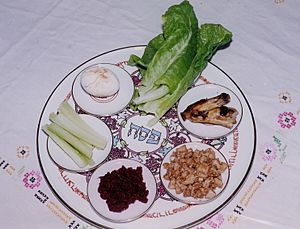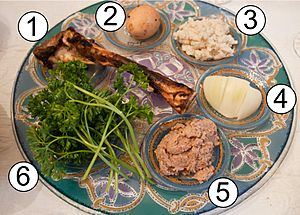Maror facts for kids


Maror is a special name for the bitter herbs eaten during the Passover Seder. The Seder is a traditional meal celebrated by Jewish people. Eating maror is part of a commandment from the Bible. It says, "with bitter herbs they shall eat it" (from the book of Exodus 12:8).
Contents
Why We Eat Maror: The Biblical Connection
The Bible mentions eating maror along with the special Paschal offering. This offering was a sacrifice made in ancient times. After the Temple in Jerusalem was destroyed in 70 CE, this offering stopped.
Today, eating maror on the first night of Passover is a rule set by Jewish religious leaders (rabbis). It is not a direct biblical command anymore, because the Paschal offering no longer exists. However, eating matzo (unleavened bread) on Passover is still a direct biblical command. This is because the Bible mentions matzo as a standalone rule.
The word maror comes from the Hebrew word "mar." This word means "bitter."
What Maror Symbolizes: The Bitterness of Slavery
The maror is a very important symbol during the Seder. It reminds everyone of the hard times. It stands for the bitterness of slavery that the Israelites faced in Egypt.
The Torah (Jewish holy texts) says: "And they embittered (ve-yimareru) their lives with hard labor." This verse helps us understand why maror is so important. It connects the bitter taste to the bitter lives of the slaves.
How Maror is Used at the Seder

1. Zeroa (shankbone)
2. Beitza (roasted hard-boiled egg)
3. Maror/Chazeret (horseradish)
4. Maror/Chazeret (onion)
5. Charoset
6. Karpas (parsley)
Maror is one of the special foods placed on the Seder Plate. Everyone at the Seder is required to eat maror. There is also a tradition called Korech. In Korech, maror is eaten together with matzo.
During the Seder, each person says a special blessing over the maror. Then, they dip it into charoset. Charoset is a sweet, brown mixture. It looks like the mortar that the Israelites used to make bricks in Egypt. After dipping, the extra charoset is shaken off. Then, the maror is eaten.
Jewish law (called halakha) says how much maror to eat. It also says how quickly to eat it. This amount is called a kezayit, which means "the size of an olive." To fulfill the rule, the maror must be raw. It should not be cooked or mixed with things like salt, vinegar, or sugar.
Types of Maror: Bitter Herbs
Ancient Jewish texts, like the Mishnah, list five kinds of bitter herbs. These include lettuce, endive or chicory, and other plants. Today, the most common bitter herbs used are horseradish and romaine lettuce.
Hazzeret (Lettuce)
Hazzeret is a type of domestic lettuce. While many modern lettuces are not bitter, older types of lettuce were. Romaine lettuce is often used today. It has a slightly bitter taste. Also, the Talmud says that romaine lettuce is not bitter at first but becomes bitter later. This is like the experience of the Jewish people in Egypt. Their lives were not bitter at first, but they became bitter later.
Tamcha (Horseradish)
Some people believe that tamcha from the ancient texts might be horseradish. Horseradish does not grow naturally in Israel. It became popular because leafy vegetables like lettuce did not grow well in colder northern places where many Jewish people lived.
Many Jewish people use horseradish. However, Jewish law says that maror should be eaten raw. It should not be cooked or mixed with sugar or other ingredients.
Other Bitter Herbs
Other types of bitter herbs mentioned in ancient texts include `ulshin (different kinds of Cichorium plants) and harhavina (possibly melilot). The plant called Sonchus oleraceus, which is related to dandelion, is also known as maror in some traditions.
See also
 In Spanish: Maror para niños
In Spanish: Maror para niños

